Do you want to achieve that V-shaped physique? Look no further than the dumbbell side lateral raise.
It is a simple yet effective exercise that can help you target the shoulders, particularly the lateral or middle deltoid muscles.
It involves lifting dumbbells out to the sides of the body while keeping the arms straight, making it an effective way to isolate and strengthen the shoulders.
In this blog, we will cover the following:
- Muscle worked during dumbbell lateral raise.
- How to perform the dumbbell side raise properly.
- Best variations of this exercise.
- How to incorporate them into your workout routine.
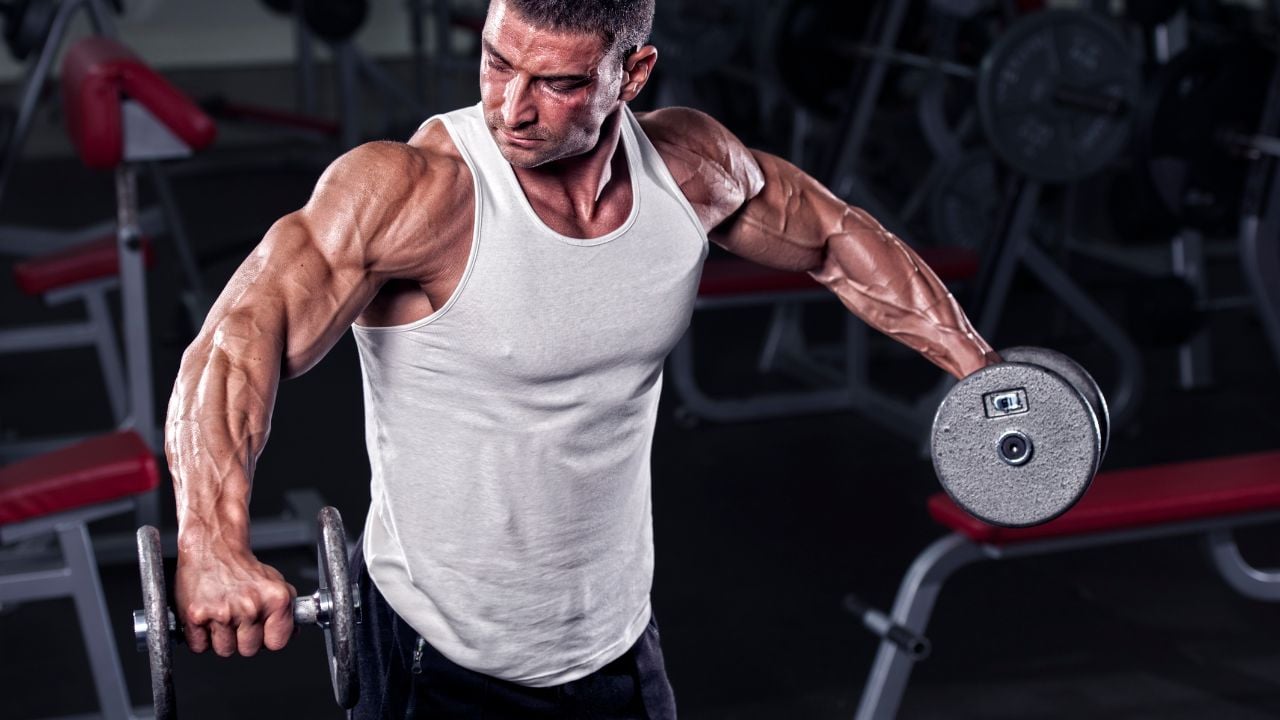
- What Is Dumbbell Lateral Raise
- Muscles Worked During Dumbbell Lateral Raise
- How To Do Dumbbell Shoulder Lateral Raise
- Common Mistakes To Avoid
- 1. Lifting Too Heavy Weights
- 2. Lifting The Weight Too High
- 3. Improper Body Positioning
- 4. Using Momentum
- 5. Incorrect Range Of Motion
- 6. Holding Breath
- Best Variations Of Shoulder Lateral Dumbbell Raise
- 1. Seated Dumbbell Lateral Raise
- 2. Dumbbell Chest Supported Lateral Raises
- 3. Dumbbell Lateral To Front Raise
- 4. Dumbbell Full Can Lateral Raise
- 5. One Arm Dumbbell Lateral Raise
- 6. Leaning Dumbbell Lateral Raise
- 7. Incline Dumbbell Side Lateral Raise.
- 8. Lying Dumbbell Lateral Raise
- Add Dumbbell Lateral Raises Into Your Workout Routine
- 1. Add Optimum No of sets and reps
- 2. During workouts, splits
- 3. Frequency
- Top Benefits of the Dumbbell Lateral Raise Exercise
- FAQs
- Can I do dumbbell lateral raises every day?
- How much weight should you use for dumbbell lateral raises?
- Can dumbbell lateral raises help with shoulder pain?
- Should I lean forward or backward during dumbbell lateral raises?
- How long should I hold the dumbbells during lateral raises?
- Conclusion
- Related Posts
What Is Dumbbell Lateral Raise
The dumbbell lateral raise is an isolation exercise that targets the lateral head of the deltoid muscle. This exercise involves lifting dumbbells to each side of your body.
Many variations of the dumbbell lateral raise challenge your muscles even more and help build strength and definition.
Some examples of variations include single-arm raises, chest-supported side raises, and dumbbell lateral to-front raises.
This exercise is great for strengthening the shoulder and should be included in your workout routine.

Muscles Worked During Dumbbell Lateral Raise
In fitness, “shoulder exercises” refer to resistance exercises that target the deltoid muscle. It has three distinct types of muscle, and a muscular torso is called a head.
- The anterior deltoid (In front)
- Lateral deltoid (at the side)
- Posterior deltoid (behind)
The primary Muscle Worked during lateral dumbbell raises is the lateral deltoid (middle portion of the deltoid muscle)
Secondary Muscle Worked: The anterior deltoid, posterior deltoid, upper trap, supraspinatus (a rotator cuff muscle), and serratus anterior (muscles along your ribs under your armpit) also contribute to the movement.
A handful of other muscles worked or play the role of stabilizer muscles, including your
- Wrist flexors,
- Obliques, and
- Rectus abdominis.
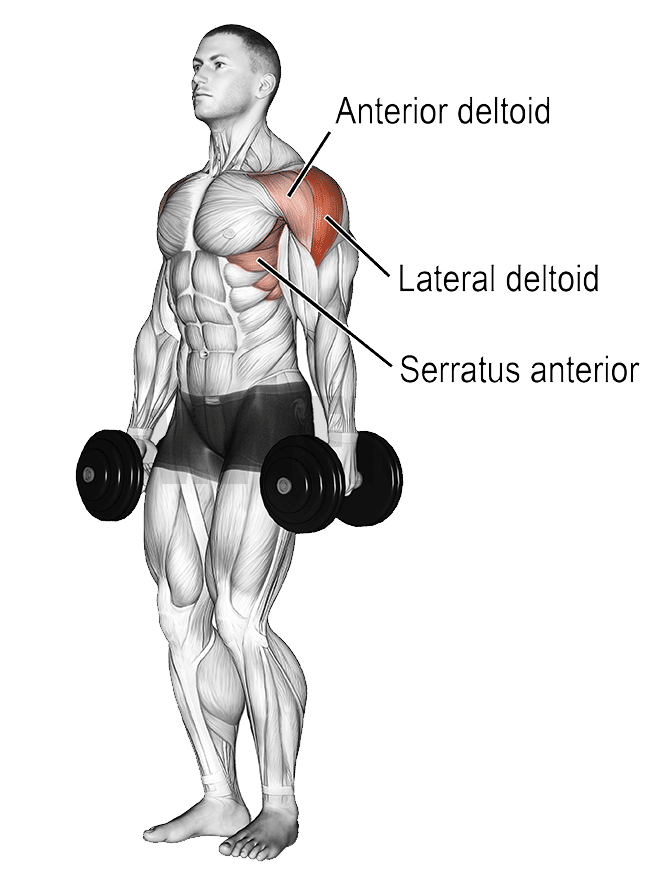
How To Do Dumbbell Shoulder Lateral Raise
Here are the steps for performing a dumbbell side raise to target the lateral head of the deltoids.
- Stand with your feet shoulder-width apart.
- Hold the dumbbells in each hand with your arms by your sides.
- Keep your core engaged and your back straight.
- Slowly lift the dumbbells to your sides, with your elbows slightly bent and your palms facing down.
- Continue lifting until your arms are parallel to the floor or slightly higher.
- Then, pause for a moment to feel the tension in your shoulders.
- Slowly lower the dumbbells back to the starting position.
- Repeat for the desired number of repetitions, typically around 10-12.
- Then, rest for a minute before performing another set.
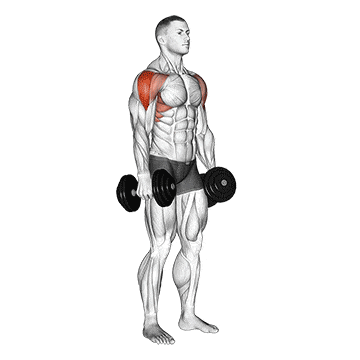
Common Mistakes To Avoid
When performing dumbbell lateral raises, people make several common mistakes.
You can maximize the effectiveness of your workout by eliminating these common mistakes.
Here are some tips on how to avoid these mistakes:
1. Lifting Too Heavy Weights
One of the most common mistakes is using too much weight. Using too heavy weights can lead to poor form, such as swinging the dumbbells or using Momentum instead of muscle strength.
Start with a lighter weight and focus on proper form before increasing weight.
2. Lifting The Weight Too High
Lifting weights above shoulder level can strain your rotator cuff muscles.
You should focus on lifting the weight to shoulder level or slightly above it.
3. Improper Body Positioning
Your body should be stable with a slight knee bend and a neutral spine. Leaning too far forward or backward can place undue stress on your back and shoulders.
To avoid this, maintain an upright posture throughout the exercise.
4. Using Momentum
Avoid using swinging movements or body momentum to perform the exercise. This makes the exercise less effective because it takes tension off the shoulder.
Also, letting the weights drop quickly after you raise them can make the exercise less effective and cause injury.
5. Incorrect Range Of Motion
Avoid short-cutting the range of motion, as this will reduce the shoulder’s tension and decrease the effectiveness of the exercise.
Lift the weights until your hands reach shoulder height, pause, and slowly lower back down.
6. Holding Breath
Many people make the mistake of holding their breath during the exercise session.
Make sure to breathe out when you lift the weight and breathe in when you lower it back down.
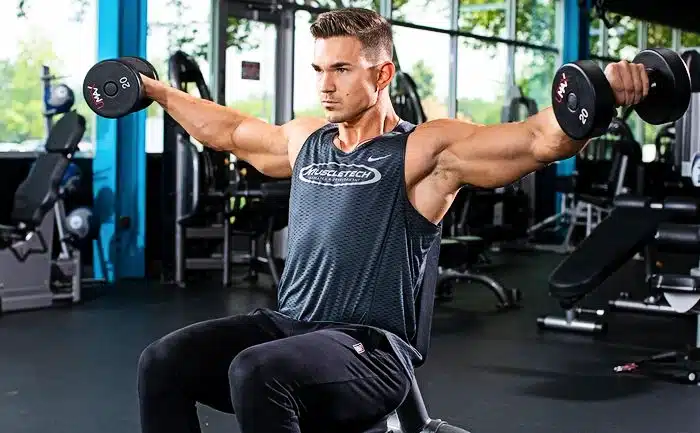
Best Variations Of Shoulder Lateral Dumbbell Raise
The standard dumbbell lateral raise works well for the shoulders, but adding variations to your routine can help you strengthen the deltoids.
Slightly altering hand position, angle, tempo, or balance challenges engage stabilizer muscles and shoulders from new angles.
If you want to improve your form, fix imbalances, prevent plateaus, or make your workout harder, try different variations of lateral raises.
1. Seated Dumbbell Lateral Raise
The seated dumbbell lateral raise is a variation of the traditional dumbbell side raise exercise, with the added benefit of increased stability and isolation of the shoulder muscles.
It’s a great way to target the lateral deltoids while minimizing the involvement of other muscle groups.
It is ideal for people who want to build shoulder strength without putting too much strain on other body parts.
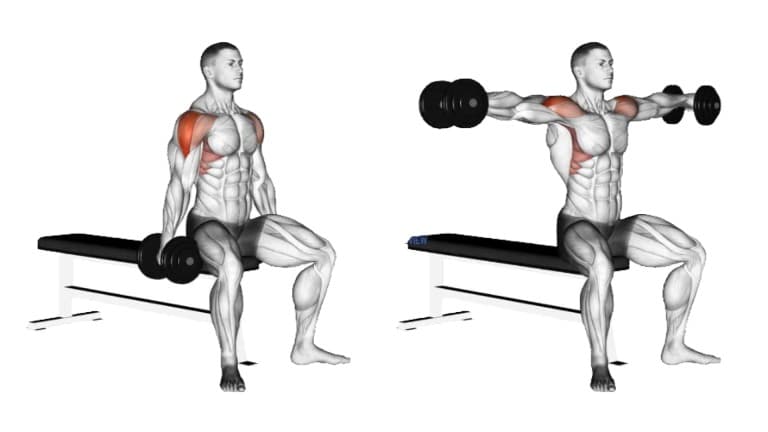
How To Do It
- Sit on a bench or chair with your feet flat on the ground and your back straight.
- Hold a dumbbell in each hand, with your arms at your sides and your elbows slightly bent.
- Slowly raise the dumbbells to the side.
- Continue lifting until your arms are parallel to the ground or just below shoulder height.
- Hold for a brief moment, and then slowly lower the dumbbells back down to the starting position.
- Repeat for the desired number of repetitions.
2. Dumbbell Chest Supported Lateral Raises
This exercise involves lying face down on an incline bench to support the chest.
This helps to isolate the lateral deltoid muscles and reduce the involvement of other muscle groups.
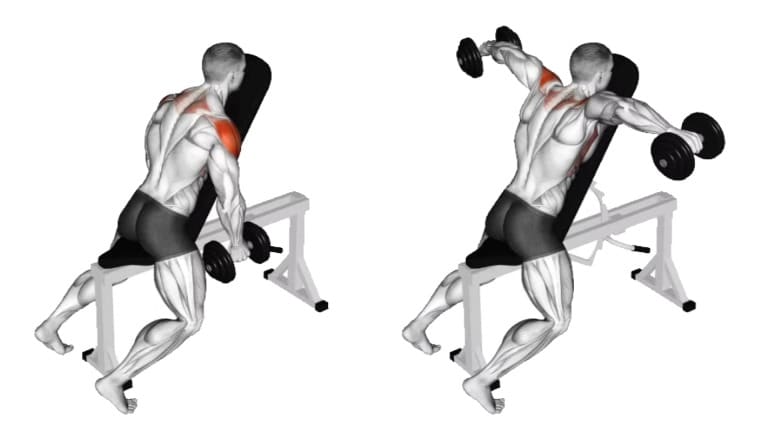
How To Do It
- Lie face down on an incline bench, with your chest and stomach resting on the bench.
- Your feet are planted firmly on the ground.
- Hold a dumbbell in each hand, with your palms facing each other.
- Keeping your elbows slightly bent, lift the dumbbells out to the sides of your body until they are at shoulder level.
- Hold for a second, then slowly lower the dumbbells back down to the starting position.
- Repeat for the desired number of repetitions.
Tips
- keep your chest and stomach firmly pressed against the bench.
- Don’t swing your arms or move your body during exercise.
3. Dumbbell Lateral To Front Raise
The dumbbell front raise to lateral raise is an exercise that combines two exercises that build and strengthen the middle deltoids and the anterior deltoids of the shoulders.
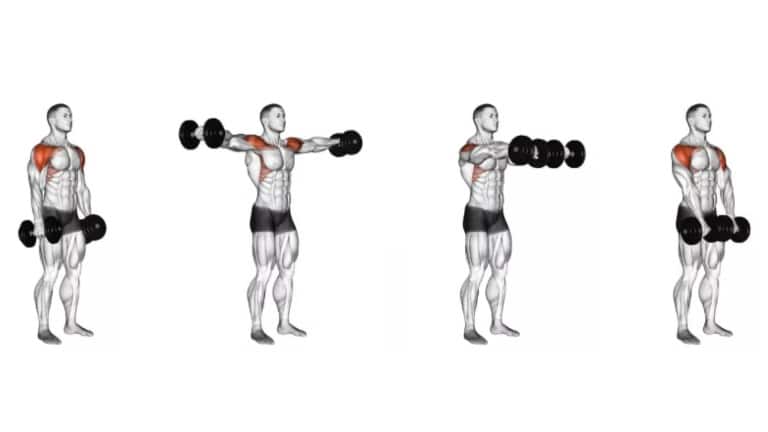
How To Do It
- Hold a pair of dumbbells at your sides with your palms facing in.
- Keeping your arms straight, raise the dumbbells to the sides until they parallel the ground.
- From here, keeping your arms straight, raise the dumbbells forward until they are at shoulder height.
- Pause momentarily, then slowly lower the dumbbells back down to the starting position.
- Repeat for the desired number of reps.
Tips
- Keep your elbows slightly bent throughout the movement.
- Keep your core engaged and your upper body stable.
- Use a weight that challenges you but allows you to maintain proper form.
4. Dumbbell Full Can Lateral Raise
The full can side raise is a great exercise for strengthening and toning the shoulder muscles, especially the lateral deltoids.
The exercise can be done with light weights, making it a great option for beginners.
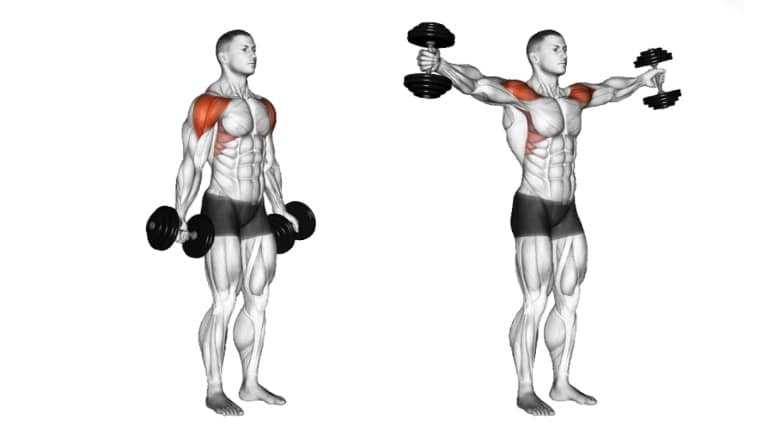
How To Do It
- Hold the dumbbells with your palms facing forward and your arms at your sides.
- Raise the weights out to your sides until they are parallel to the floor.
- Your hands should be positioned as if you were holding a can by the top of the can, hence the name “full can.”
- Pause momentarily, then slowly lower the dumbbells back to the starting position.
- Repeat for the desired number of repetitions.
Tips
- Make sure to keep your back straight and engage your core.
- Don’t swing your arms to generate Momentum.
5. One Arm Dumbbell Lateral Raise
Single-arm dumbbell side raise is an excellent exercise to isolate and build side deltoids.
This dumbbell shoulder exercise is performed with one arm at a time.
To build the middle head of the deltoid muscle, do a dumbbell one-arm lateral raise as part of your deltoid exercises.

How To Do It
- Stand holding a dumbbell with one hand. The feet are shoulder-width apart, and the knees are slightly bent.
- Now bend your elbow and raise the dumbbell to your side.
- Lift them to a point slightly higher than your shoulder. Now lower the dumbbell in a controlled manner back to the starting position.
- Perform all reps on one side and then repeat with the other arm.
Tips
- Pause momentarily at the top before slowly lowering the dumbbell back to the starting position.
- Keep a controlled motion and avoid jerky movements.
- Avoid arching of the lower back.
6. Leaning Dumbbell Lateral Raise
Leaning away lateral raise is more effective than the dumbbell side raise because it puts your lateral deltoid under tension through a greater portion of the range of motion.
The leaning position maximizes the isolation of the shoulders throughout the movement.
It also places greater overload at the top of the movement.

How To Do It
- Hold a dumbbell with one hand and grab anything stable with your free hand.
- Position both feet under the hand with which you are grasping the pole and lean out to the side holding the dumbbell.
- Adjust your hips slightly so that you are leaning forward.
- Lift them to a point slightly higher than your shoulder.
- Now lower the dumbbell in a controlled manner back to the starting position.
- Perform all reps on one side and then repeat with the other arm.
7. Incline Dumbbell Side Lateral Raise.
If you’re looking for a way to get more creative with your dumbbell lateral raise, why not try an incline lateral raise?
Many of the movements that work the same muscle group may look alike, but they focus on different parts of the muscles because they are at different angles.
If you want to develop better muscle specifically, remember that including exercises focusing on different aspects of your training program is more beneficial.
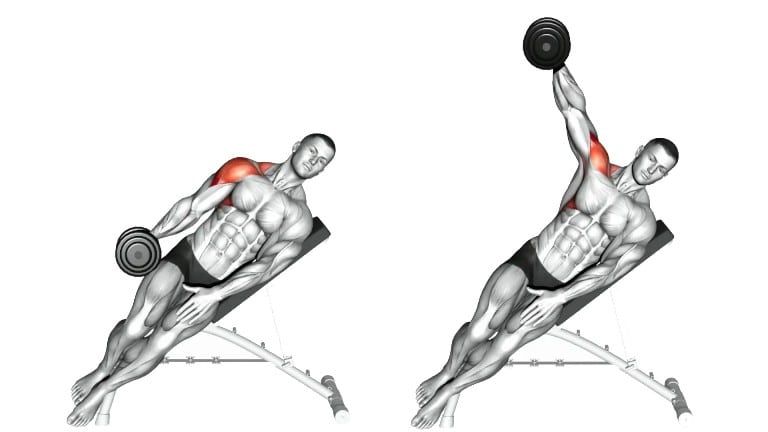
How To Do It
- Lie sideways on an incline bench, set at 55 degrees, with your armpit over the top of the bench.
- Hold the dumbbell so that it rests sideways on your upper thigh.
- Keeping a slight bend in your elbow, raise the dumbbell out from your side until your elbow is in line with your shoulder.
- Pause a moment at the top of the motion before slowly lowering the weights back down to the starting position.
Tips
- Do not shrug your shoulders when raising the dumbbell.
- Focus on moving in a slow and controlled fashion the entire time.
- Your working elbow should be slightly bent during the lift.
8. Lying Dumbbell Lateral Raise
Lying dumbbell lateral raise is perhaps difficult for beginners, but it is an interesting variation on conventional lateral raises.
It increases strength and stability throughout the entire shoulder.
Having a great lateral head will give the illusion of a super-wide set of shoulders.

How To Do It
- Lie sideways on a flat bench, propping yourself up onto your elbow so it is perpendicular to the bench.
- Hold the dumbbells so that they rest sideways on your upper thigh
- Slowly lift the dumbbells up and out to the sides of your body, pulling through the rear delts and middle traps.
- Pause a moment at the top of the motion before slowly lowering the weights back down to the starting position.
- The “top” of the movement is when the shoulder joint is at a 90-degree angle to the body.
Tips
- Do not lift backward or forward.
- Avoid using Momentum. Focus on moving in a slow and controlled fashion the entire time.
- Your working elbow should be slightly bent during the lift.
Add Dumbbell Lateral Raises Into Your Workout Routine
Incorporate dumbbell lateral raises into your shoulder workout routine to V-shape body.
1. Add Optimum No of sets and reps
A good starting point is to perform 3–4 sets of 8–12 reps.
However, you can adjust the number of sets and reps according to your fitness level and goals.
2. During workouts, splits
You can perform dumbbell lateral raises as part of an upper body or during a push-pull leg workout Split.
3. Frequency
You can do dumbbell lateral raises once or twice a week.
However, allowing your muscles to recover between workouts is important to maximize results.
Top Benefits of the Dumbbell Lateral Raise Exercise
- Strengthens the Shoulder Muscles: It strengthens shoulder muscles by targeting specific target muscle groups, such as deltoids, trapezius, and rotator cuffs. When done correctly, it can also help to improve posture and balance.
- Increases Upper Body Strength: This exercise can help build and strengthen shoulder muscles. Lifting weights helps you do everyday things more easily.
- Increases Range of Motion in the Shoulders: It gives you a more complete workout and improves in your flexibility and strength. It helps to improve overall mobility and flexibility.
- Builds Arm Muscle Endurance: Improve muscular endurance in your arms and shoulders. Muscular endurance can help you work longer without becoming tired.
FAQs
Can I do dumbbell lateral raises every day?
It’s not recommended to perform dumbbell lateral raises every day. Like all weightlifting exercises, your muscles need time to rest and recover in between workouts.
It’s recommended to perform dumbbell lateral raises 2–3 times per week, with a rest day in between.
How much weight should you use for dumbbell lateral raises?
If you are a beginner, start with a lighter weight, such as 5–10 pounds per dumbbell.
As you get stronger, you can increase the weight to 10–15 pounds per dumbbell.
Can dumbbell lateral raises help with shoulder pain?
Dumbbell lateral raises can help strengthen the muscles surrounding the shoulder joint, which can help alleviate shoulder pain. However, if you have an existing shoulder injury or pain,
Should I lean forward or backward during dumbbell lateral raises?
Maintain an upright posture during dumbbell lateral raises.
Leaning too far forward can put excess strain on your lower back, while leaning too far backward can strain your neck.
How long should I hold the dumbbells during lateral raises?
Hold the dumbbells for 1–2 seconds at the top of the movement before lowering them back down to the starting position.
This can help engage the lateral deltoid muscles and improve the effectiveness of the exercise.
Conclusion
Dumbbell lateral raises are a highly effective exercise for building stronger and more defined shoulders. Just a pair of dumbbells and a bench can be used to perform the exercise.
So why not try the dumbbell lateral raise and see the results for yourself?
Related Posts
- 10 Best Single-Arm Shoulder Exercises to Build Deltoids
- Single Arm Lateral Raise: Muscle Worked, Benefits, Tips
- Best cable shoulder Workout for 3D Shoulders
- Best Anterior deltoid (Front Deltoid) Exercises & Workout
- 14 Best Cable Chest Exercises and Workout Routine

Manish brings over 10 years of hands-on experience in weight lifting and fat loss to fitness coaching. He specializes in gym-based training and has a lot of knowledge about exercise, lifting technique, biomechanics, and more.
Through “Fit Life Regime,” he generously shares the insights he’s gained over a decade in the field. His goal is to equip others with the knowledge to start their own fitness journey.
